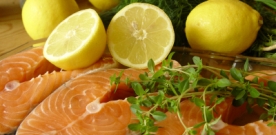Cooking With Fin-Esse
Tips for Buying and Preparing Seafood
By: Jodie Shield, RD
It’s Lent. And I’ve had several requests for fish stories and recipes. Some of you even confessed that you’re hesitant to cook fish because it’s too complicated. Let me try to reel you in. Fish takes only minutes to cook – it’s the original fast food! Plus, fish is so good for you. It’s a lean source of high quality protein and most seafood has omega-3- fatty acids which have been linked to reducing your risk of stroke. For maximum health benefits, the current recommendation is to aim for eating seafood at least twice a week. Here are a few purchasing and preparation pointers from the National Fisheries Institute to help get you hooked on cooking fish. Catch my blog on Friday as I will be posting one of my favorite seafood recipes! In the meantime, got any fish stories you’d like to tell?
When you buy fish:
- Purchase seafood from reputable, commercial sources, and choose glistening, flawless fish that smells fresh.
- Choose fresh or frozen fish that is boneless. this will keep your child from choking on tiny, hard-to-see bones.
- Look for whole fresh fish with bright, clear, and shiny eyes. Scales should also be shiny and cling tightly to the skin. Gills should be bright pink or red in appearance.
- Choose steaks and fillets that are moist and not brown around the edges. The flesh should be firm and spring back when pressed.
When you prepare fish:
- Cook it within three day of buying it. Always thaw frozen seafood in the refrigerator or under cold running water.
- Add flavor by using marinades and rubs. For safety reasons, marinate seafood in your refrigerator (not on a countertop at room temperature), and discard any leftover marinade.
- Cook fish until its meat begins to flake when tested with a fork and it loses its raw appearance. Like all foods, fish should be thoroughly cooked, especially when served to children. The FDA suggest cooking fish until it reaches an internal temperature of 145 degrees F, which can be tested with a meat thermometer.
- Remember that shellfish cooks quickly. Cook shrimp about two to three minutes, or until the shrimp turns red and the flesh becomes opaque. Scallops take about three to four minutes to cook thoroughly. Clams, mussels, and oysters pop open their shells when they’re done, in about five minutes’ time. (Don’t eat any with unopened shells.) And a one-and-a-half pound lobster takes about 15 minutes to boil.
- Use the “10 minute rule” when cooking fin fish. Here’s how it works:
- Use a ruler to measure the seafood at its thickest point.
- At 450 degrees F, cook the fish for 10 minutes per inch of thickness; turn the fish over halfway during cooking time. (A one-inch-thick steak should cook for five minutes on each side, for a total of 10 minutes.) Fish that is less than one-half inch thick doesn’t need to be turned.
- If cooking fish in foil or in a sauce, add five minutes to the cooking time.
- Double the cooking time (20 minutes per inch) foir frozen fish that has not been defrosted.







posted by Renee Colton on March 4, 2013
I love marinated salmon. I use a bit of brown sugar rubbed in along with some sea salt. Then I cover with a slice of pineapple, wrap in parchment paper and cook at 325 for about 30 minutes! Delicious with a side salad for a complete meal of yummy nutrition!
posted by Conor on March 5, 2013
Whenever I cook fish it never comes out as good as I want it to be. I love how detailed your cooking instructions are maybe I will try it and let you know how it goes! It looks delicious, now if only I can make it look that good.